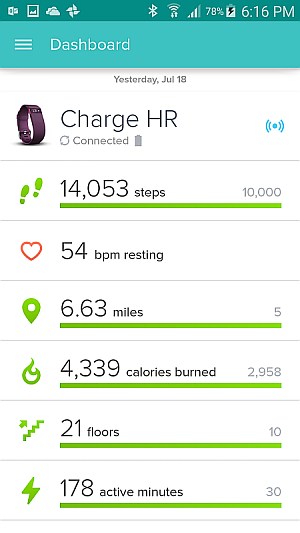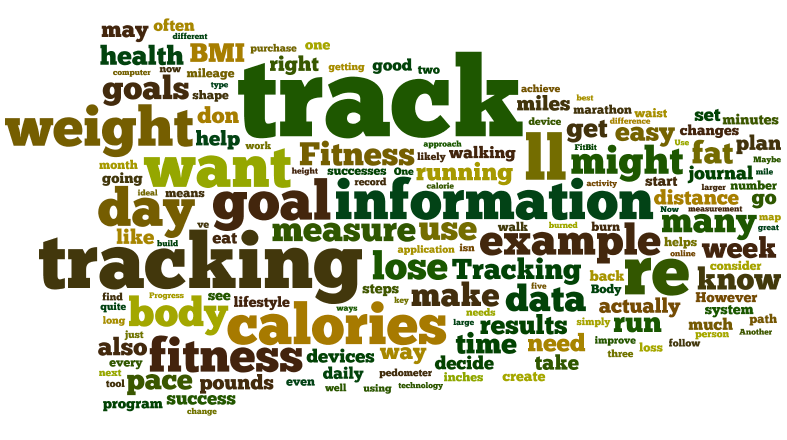There are many keys to weight loss success. On the quest to lose weight, get in shape, and improve your health, a few fundamentals can make all the difference. They can make the path to a healthy lifestyle much easier.
Sounds, great, right? Losing weight and getting in shape is a challenge in and of itself so why make it harder than it needs to be?
One of the key fundamentals of successful weight loss and fitness is the concept of fitness tracking. It is also the concept that is most often overlooked or ignored.
What is Fitness Tracking?
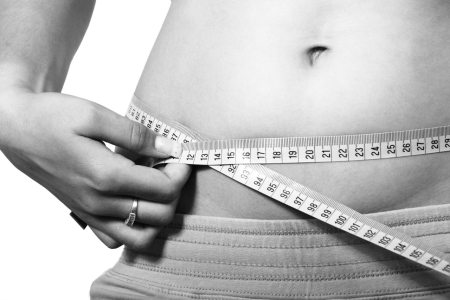 Fitness tracking is simply the practice of tracking your results or actions over time. There are actually several different fitness and health related data points that you can track.
Fitness tracking is simply the practice of tracking your results or actions over time. There are actually several different fitness and health related data points that you can track.
For example, you might track the pounds you lose each day or week. Or you might track the number of miles you walk or the calories you burn.
We’ll talk about what to track, how to decide, and how to track it over the next couple of pages.
For now, know that the data you track and the choice you make depends on your goals and personal preference.
For example, if your goal is to run a 5k or a marathon then you might track your mileage and/or pace. If your goal is to lose weight through dietary changes then you might keep a food journal or track your calories.
In addition to having a variety of data to choose from there are also many different ways to track that information. Your fitness tracking can be as simple as pen and paper or as technical as using a device to track and record the information for you.
The most important thing is to find a system that works for you. Fitness tracking results are only as good as your system. IF you don’t actually follow through and track the information then you won’t reap the many benefits.
The Benefits of Tracking Your Progress
Speaking of benefits, you may be thinking at this point that all of this tracking sounds like more work than it’s worth. That couldn’t be further from the truth. There are tremendous benefits to be gained when you simply track and review your fitness data.
Motivation and Fitness
One of the most persistent challenges anyone faces when trying to get in shape and/or lose weight is the challenge of finding the motivation to actually follow through. It’s easy to say you’ll run for twenty minutes a day and not as easy to actually put the shoes on and get out the front door. It’s easy to say “I’ll stop eating junk,” and less easy to break the habit.
Motivation is key.
Tracking the data helps you see what you’ve accomplished and where you want to go. When you consistently track the information that is relevant to your goal, you’ll be able to see tangible results. One of the reasons that motivation is so difficult to find is that often you don’t see immediate results for your efforts.
For example, for your fitness tracking let’s say that you want to get in shape and decide to use “inches lost” as your measurement. You take a few steps to change your diet and increase your fitness.
For the first month or even two months you may not lose much weight depending on your new lifestyle changes.
However, you will likely lose inches and you wouldn’t know that you’re making progress unless you actually measured. This measurable progress is extremely motivating. Fitness tracking can be the key to you actually following through on your goals.
Goal Setting
Speaking of goals, there’s no benefit to merely tracking information for the sake of tracking it. You need to set a goal. And setting a goal helps you create a target. Consider the difference in success between the two statements:
“I want to lose weight.”
“I want to lose 30 pounds.”
Or
“I want to start a running program.”
“I want to train for and run a marathon in six months.”
The difference is tremendous. One statement gives you something very specific to focus on and the other is more like a dream. You might as well say, “I wish I could lose weight. Or I wish I could start a running program.” These are not effective statements. Goals are what get you to where you want to be.
Accountability to Make Sure You Succeed
When you don’t have someone at your back urging you to follow through and holding you accountable, it’s so very easy to get off track. Fitness tracking is often the only thing a person has to help them stay accountable to themselves and their goals.
Imagine looking at your fitness journal every day. You know that if you skip a day, you’ll track lackluster results. You won’t achieve your goal. Yet if you follow through you’ll be pleased not only with yourself but also with your results. Tracking the information helps you hold yourself accountable. It’s actually quite powerful.
Planning for Fitness Tracking
Just setting a goal isn’t enough. You need to have a plan to turn that goal into a reality. Simply saying “I want to run a marathon in six months” won’t make it happen. You have to decide how you’re going to achieve that goal.
Fitness tracking helps you create a realistic and achievable plan.
For example, let’s say that you want to lose thirty pounds. You decide that three pounds a week is a reasonable goal. So that means you have ten weeks to lose the weight. You now know what your weekly goal is and you can plan how you’re going to achieve it. Fitness tracking forces you to break down larger goals into smaller bite sized pieces. It forces you to plan.
Celebration of Your Goals
 This ties right back into the motivation benefit because there’s nothing quite as powerful as success. When you achieve your day-to-day goals, and you celebrate those successes it accomplished two key things:
This ties right back into the motivation benefit because there’s nothing quite as powerful as success. When you achieve your day-to-day goals, and you celebrate those successes it accomplished two key things:
It helps you get through the rough days. You know you’ve achieved success in the past and it pushes you through those times when you just don’t reach your goals.
It motivates you to push harder, set bigger goals, and take larger steps to achieve them.
There’s no motivator quite like creating a habit of success and fitness tracking is one of the best ways to not only witness those day to day successes but to celebrate them. Speaking of celebration, consider how you want to reward yourself for your large and small successes. (Hint: think about rewards that are good for you.
For example, you might purchase a new blender to make smoothies or you might buy a new workout outfit for the larger successes. You might treat yourself to a favorite movie or a day at the park or beach for a smaller celebration.)
Now that you’re motivated to start tracking your fitness it’s time to decide what to measure. Let’s take a look at some of the many options.
What Should You Measure?
In this section we’re going to outline a few of the many types of information that you can track. We’ll discuss why you might want to track the information and what goal(s) the data might support. In the following section we’ll go into detail about the different approaches, tools, and techniques for tracking your fitness information.
Miles Walked or Run
Why track miles? If you are starting a walking, running, or cycling program than it makes great sense to track your daily, weekly, and even your monthly mileage. Let’s go back to the example of someone who sets the fitness goal of running a marathon. It’s a popular goal and certainly one that can help a person get into great shape and lose weight too.
 If your goal is to run a marathon, or to walk one, then you might decide to start your plan by walking or running three miles a day. You may need to build up to this so for the first week or two you’d walk/run the distance.
If your goal is to run a marathon, or to walk one, then you might decide to start your plan by walking or running three miles a day. You may need to build up to this so for the first week or two you’d walk/run the distance.
You could then track how much time you spent walking and running each day. The first day, maybe you only run for a total of ten minutes and the rest of the time is spent walking. Then you know that tomorrow you’ll aim to run for at least 11 minutes. Baby steps are still progress.
By the end of the month you’ll likely be able to run 3 miles every day without stopping. Your next goal may be to add a mile to your distance each week. Five days a week you run for three miles and the sixth day you run four miles. The next week you up it to five miles and so on.
Soon you’ll be running one very long run each week and building your base for marathon day. As you can see, tracking your mileage can be critical to your success with this type of goal. It also works for any other type of program where distance is your goal.
Another reason to track your mileage might be if you’re wearing a pedometer and striving to reach a daily mileage goal. Using the pedometer you can track your steps or miles and gradually take measures to build on your daily and weekly mileage.
With both of these examples, it’s imperative that you have some sort of tool to measure. To track your steps or daily walking miles you’ll need a pedometer. It’s impossible to guess how much you walk each day.
A tool is required. For running, cycling, or walking distance goals you can map out a path using a tool like mapmyrun.com or Google pedometer.
It’ll show you the distance for any path you create. You can then use this data to plan and calculate your distance. GPS watches are also useful but we’ll talk more about tools and technology in the next section.
Calories Taken In (What you eat)
Many people choose to use calories as a means to lose weight. It’s important to know that while this can be effective, not all calories are created equally. Calories from an apple are used differently in your body than calories from a cookie. Spend your calories wisely.
That being said, people on a low calorie diet can and do lose weight because they burn more than they consume. This is usually not a long-term solution to weight loss but when it’s combined with dietary changes and exercise it can be part of an overall plan to get healthy.
Tracking calories can be difficult. One of the reasons is that the serving size for foods varies. You’ll not only need to know how many calories per ounce but also how many ounces you’re eating. Calorie breakdowns on a nutrition label are only part of the solution. There are some wonderful online resources that help you identify how many calories are in various foods as well.
When tracking calories you will likely want to set a daily goal and then create a system to track your calories as you eat.
For example, after you eat breakfast you’ll record your calories. After lunch, you’ll record your calories and so on. You’ll keep a running tally so you know how many calories you have left during the day. You may also want to track how many calories you burn.
For example, if you’re on a 1200 daily calorie plan and you end up going for a three-hour hike, you’re going to need more calories in your body than your regular 1200.
Tracking calories consumed and calories burned is the best way to make sure you’re giving your body what it needs, but not more than it needs. It is helpful to know that a pound of fat is 3500 calories. So if your goal is to lose a pound a week then you know that over the course of seven days you need to burn 3500 more calories than you’ve eaten.
Pace of Exercise
Pace is the rate at which you performed an activity. It’s a measurement of time and speed.
For example, you’ll burn more calories if you walk a 12-minute mile than if you walk a 20-minute mile. If you have calorie burning goals, weight loss goals, or you want to run or bike a fast race then you may want to track your pace.
When tracking pace there are several different approaches you can take. You might work on intervals.
For example, you walk at a fifteen-minute pace for five minutes and then increase the pace to twelve minute pace for five minutes. Alternating like this helps you build up not only your stamina and endurance, it burns more calories. Runners often take an interval approach when they’re trying to increase their race time.
You’ll want to decide what your goals are and why you’re tracking your pace. Then you can decide how to approach it.
For example, if you’re using an interval approach then you may want to document how long each interval should be and then documents your goal pace as well as the pace you actually achieved.
Another approach might be to simply work on increasing your pace over time. You might start with a 15-minute mile jogging pace with the goal to get it down to a 10 minute pace. Each week you aim to improve your pace/time by 30 seconds. Tracking your results after each run will help you determine what’s possible and it’ll help you plan for success.
Event (what you did today)
Sometimes a person has the goal to simply be more active. They may decide that they want to do something active each day for at least twenty minutes. In this case, instead of tracking measureable data, you’ll track your event. You’ll answer the question, what did I do today that was active? Maybe you went to a yoga class. Maybe you walked the dog. Maybe you jumped rope or went for a swim. Simply getting off of the couch or out of the chair and getting daily activity each day can go a long way toward improving your health and fitness.
Inches Starting And Lost Over Time
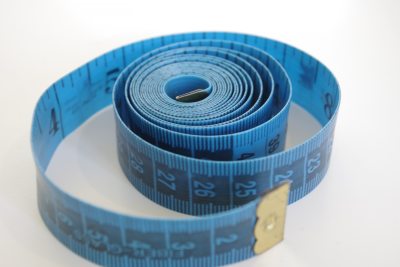 Another wonderful way to measure your health and fitness is to measure inches lost, or gained if you’re striving to build muscle.
Another wonderful way to measure your health and fitness is to measure inches lost, or gained if you’re striving to build muscle.
This is simple enough to track and evaluate and one of the best ways to track this information if you’re trying to lose weight is to measure inches around your waist.
For example, many doctors recommend a woman’s waist size be less than 30 inches and a man’s to be less than 35. If your waist is larger than this then your goal is to get it below the optimal number for your gender.
Now of course simply measuring your waist at the end of the week isn’t enough. It’s not going to shrink just because you want it to. However, knowing your starting number and your goal number will help you take the right steps.
You might make dietary and exercise changes and measure their effectiveness. If you run for a month and eat fewer calories you’ll undoubtedly see a reduction in your waist size. Tracking the data serves as a means to motivate you and to evaluate your lifestyle and make changes.
BMI – Body Mass Index
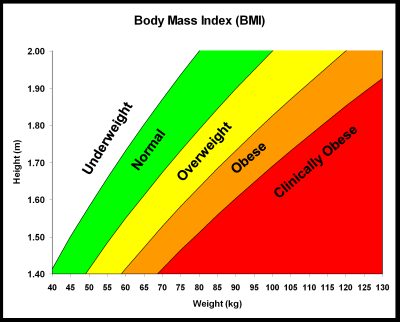 According to the Department of Health and Human Services, the following are the BMI ranges for various health statuses:
According to the Department of Health and Human Services, the following are the BMI ranges for various health statuses:
- Underweight = <18.5
- Normal weight = 18.5–24.9
- Overweight = 25–29.9
- Obesity = BMI of 30 or greater
So how do you calculate you’re BMI and what does the information mean?
Body Mass is actually a percentage of your height to your weight. It is your weight divided by your height.
For example, if you weigh 200 pounds and you’re five feet tall than your BMI is 39.1.
There are limitations to BMI. It doesn’t measure body fat. A person with large bones and a large muscle mass will weigh a lot. If the ratio of their height to their weight is large then they’ll have a substantial BMI – they can be in the obese category even if they don’t have a high body fat percentage. A body builder is a prime example of this limitation. They generally have a very high BMI but are nowhere near being classified as obese as body builders usually have extremely low body fat.
So while BMI is generally a good indicator of weight and obesity, it’s not an ideal indicator. If you’re tracking BMI, consider also tracking other data points so that you know you’re striving toward optimal health.
Body Fat Tracking
Body fat is perhaps a more reliable measurement of health. However, it can be tricky to measure.
There are scales that you can purchase which measure body fat by sending a harmless electric current through your body when you step on the scale. The slower it moves through your body, the more fat you have. Unfortunately, this isn’t a very accurate way to measure body fat. It can change during the day depending on a number of factors.
The Skinfold test is another way to measure body fat. To do this, you’ll need a skinfold caliper. It’s often easier to have this tested at the doctor’s office or by a personal trainer.
Another way to measure body fat is with a body fat calculator that takes your height, weight, waist circumference, neck circumference and the circumference of your thigh or hips. These numbers are crunched into a formula and you can get your BMI as well as your body fat percentage. There are underwater hydrostatic tests, which are incredibly accurate and can be tested by a service.
Whichever method you use to measure your initial body fat is the measurement you should continue to use.
For example, if you use a calculator to establish your body weight right now, then when you measure it again next month, use the same calculator. Like BMI or inches, knowing your body fat is a data point that will help you make lifestyle changes. As the number decreases you know you’re on the right path to a healthier lifestyle.
Pounds Lost or Gained
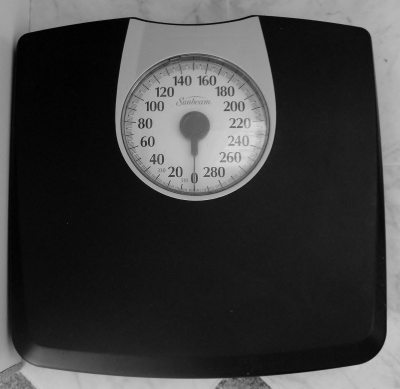 A simple thing to track on your quest for better health and fitness are the pounds you lose each day, week or month. This is easy to measure and easy to track.
A simple thing to track on your quest for better health and fitness are the pounds you lose each day, week or month. This is easy to measure and easy to track.
However, it’s not always as motivating because there may be some weeks where you lose a lot and some where you don’t. If you’re considering using pounds as your primary metric, consider using another data point to back it up.
For example, how are you going to lose those pounds? Maybe you’ll swim every day. Then track how long you swim in terms of meters or minutes. Increase your time and use fitness tracking as a means to motivate more activity. The pounds will come off more easily and the two data points will be more motivational and more powerful.
Meals/Food
Sometimes all life needs is a little tweaking to get you back into the healthy lifestyle you once enjoyed. If this is the case then consider tracking your meals or tracking the food that you eat. This is also helpful for weight loss because we often don’t realize how much we eat and how much of that food isn’t good for us.
You might set a goal to eat nine servings of vegetables and fruit each day and then use a tracking system to measure your results. You might create a plan to eat three meals and two snacks each day each within a specific calorie and fat count. Food tracking can be whatever you need it to be and it can be incredibly useful information.
Now that you have some idea of what you want to track and how to set goals that fit your desired needs, it’s time to take a look at the tools you can use to track the information. Like your health and fitness goals, the tool you choose should support you. It should be easy and even fun for you to use because the only way to succeed is if you follow through and actually track your results.
Tools You Can Use to Track Your Fitness
As you evaluate the various options, consider how you track other information in your life right now.
For example, do you use a paper calendar to schedule appointments and meetings or do you use an application for your smart phone? Do you track your finances with software or do you have a printable budget that you use each month? What’s your tracking personality and what type of system are you more likely to use and enjoy?
Journals
Fitness tracking is at its simplest when it comes in the form of a good old-fashioned fitness journal. Now you can purchase journals that are designed to help you reach speck goals.
Click here for Free printable exercise log sheets
For example a running journal will be set up to track miles and pace. A strength-training journal will be set up to record repetitions, weight, and sets. A weight loss journal might be set up to measure pounds lost and calories consumed or burned.
If your goals fit into one of these predetermined categories then buying a readymade journal is an easy way to start your tracking process. However more often than not there are bits of information that you want to track that a readymade journal just doesn’t offer.
You can make your own fitness journal. Composition notebooks are ideal for this. Simply set up the notebook to track the daily information you want it to track and you’re good to go. Over time you’ll want to label your notebooks because you’ll undoubtedly collect many of them.
Spreadsheets for Fitness Tracking
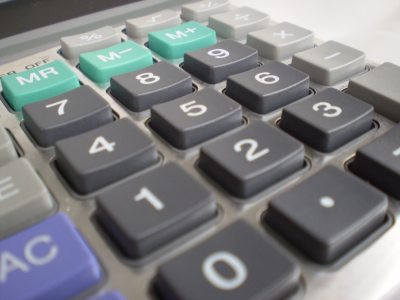 Spreadsheets are easy to use and easy to access. You can also print out a spreadsheet if you want to track the information by hand but want a more organized system for your data.
Spreadsheets are easy to use and easy to access. You can also print out a spreadsheet if you want to track the information by hand but want a more organized system for your data.
And if you have a smart phone then most spreadsheets are accessible online or can be easily shared.
This makes it easy for you to track your data when you’re on the go. And while spreadsheets are easily modifiable, you’ll have to create the spreadsheet and your tracking system yourself or find a template online.
Applications
Applications are the trend for fitness tracking. In fact, if there’s information you want to track, chances are there’s an app for that. They’re super if you enjoy technology and have the means to access the application wherever you are.
For example, maybe you don’t have a smart phone but you do have a computer. You can access the application on your computer but don’t’ have it with you when you’re out and about. In this case you may need another interim method to track your data.
Some applications can be quite expensive so make sure to review the application well before you purchase. Many have “light” versions that are free. This is a great way to try out an application before you purchase the full-scale version.
Software and Gadgets
Fitness technology has come a long way. There are some truly incredibly devices that literally do all of the tracking work for you. Let’s take a look at some of the basic technology devices and related software then you can do some comparison shopping to find the right tool for you.
Pedometers and Activity Trackers
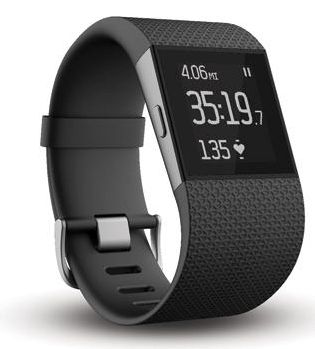 There are now devices that you can wear which track your every movement. They range from simple clip on devices like the FitBit to arm bands and even watches. These devices track your movement in many ways.
There are now devices that you can wear which track your every movement. They range from simple clip on devices like the FitBit to arm bands and even watches. These devices track your movement in many ways.
They track steps like a pedometer. However, they can track the three dimensional movement of your body so if you’re running your movements will be tracked differently than if you’re walking. They track intensity and calories burned based on their interpretation of your movements and they’re quite accurate.
These devices then sync with a wireless device that uploads all of your information to a computer program. This program is accessed online or it’s installed on your computer. You can then see at a glance what you’ve accomplished for the day and over time. And most devices and systems allow you to change or add to the information.
For example, the FitBit lets you upload the food you’ve eaten for the day so you can compare calories consumed with calories burned. It tracks distance traveled and it even tracks how you slept. There are many other devices like the FitBit and they’re getting more advanced every day.
GPS Devices
Global Positioning Devices are spectacular if you want to track distance. They also track elevation and pace. They’re ideal if you’re starting any type of running, walking, or cycling program. They’ll likely track all the information you need to know. And like the Activity Trackers mentioned previously, they download this information either through USB connection or wirelessly.
Most GPS systems are watches because they’re easy to wear. However, Nike and Apple teamed up to create iPod applications that use your iPod as a GPS device. It’s a combination of tactics that also lets you listen to music as you work out.
Watches
And of course you can’t go wrong with a basic sports watch that tracks distance, time, and intervals. You can then write down or document the data for your workout and you’re good to go.
The choice between devices and systems is up to you. Consider your personality and how you tend to utilize information. If you want to be able to see the data quickly and record it with little effort then an activity device like the FitBit or the BodyBugg may be an ideal solution.
On the other hand, many people just can’t go wrong with a little notebook and a pen. Decide what’s right for you then embrace it completely and watch your fitness and health results skyrocket. Fitness tracking will make a huge difference in your quest to improve your life.
Wrapping Up & Tips to Use Tracking and Follow Through
As you begin your quest for better fitness and improved health, take time to step back and assess the process. Consider what is working, what isn’t and what you need to change to improve your systems.
For example, if you find that tracking your time and distance every day is just too much for you to track, consider investing in a device that retains your information for a week or more. You can download the week’s information once a week and review the results.
Step back and assess often. The best way to stay on a path toward success is to make sure the path you’re on is the right one for you. You have to assess. And don’t forget to reward yourself for your successes and to forgive yourself for the failures.
Losing weight and getting in shape is a process. There will be ups. There will be downs. That’s why it’s so important to track your results. You can acknowledge and appreciate the ups and the successes and this information will help you push through those downs.
In so many cases once a person starts tracking their fitness results, they never stop. They learn to appreciate the value of the right information. They learn that they don’t intuitively know how much they eat or how many calories they burn. And they learn the power of knowledge to help them make good decisions about their health and their lives.
You wouldn’t head out on a cross-country journey without a map and a means of tracking where you are. Why would you start trying to make lifestyle changes to improve your health without a map and tools to identify where you are? That’s all fitness tracking really is, it’s a map to show you where you are and where you want to go. It’s a map for success.
